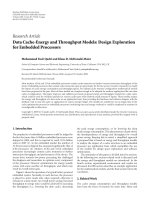Data Warehouse Architecture and Models
Bạn đang xem bản rút gọn của tài liệu. Xem và tải ngay bản đầy đủ của tài liệu tại đây (587.83 KB, 26 trang )
Lesson 4
Data Warehouse
Architecture and Models
Objectives
Differentiate between an enterprise-wide data
warehouse and localized data marts
Recognize the difference between independent
and dependent data marts
Identify the data that is stored in a data
warehouse
Explain the features of each type of data by
examining where and why it is used
List the data models that may already exist in a
company and describe where they may be
useful to the warehouse model
Explain the two common data warehouse
models
Warehouse Architectures
Enterprise-wide solution
Data mart solution
Combined solution
Enterprise Data Warehouse Solution
Large warehouse
containing all business
data
Incremental
implementation
First increment provides
proof-of-concept
Funded at corporate level
Data Mart Solution
Independent
Use a consistent
approach
Avoid disjointed
development
Consider the big
picture
Dependent
Localization
Subsets of summary
data
Oracle Data Mart Suite
for a pre-configured
solution
Funded departmentally
Independent
Independent
Dependent
Dependent
Create a Project Team
Staff with experts
Database designers
Database administrators
Network specialists
ETT specialists
Project managers
Consider training plans
Identify the Data Requirements
Successful warehouses provide the right
information
Analyze business users’ needs
Interview users
Examine data needed
Ascertain data availability
Determine data frequency
Decide the refresh cycle
Types of Warehouse Data
Fact data - Measures
Dimension data - Query
drivers
Summary data - Pre-calculated
data
Fact Data and Tables
Many fact tables in the warehouse
The bulk of the warehouse data
Measures (units sold, sales figures, calls)
Millions of rows
Multi-part primary keys
Summaries
Normalized data
Partitioning Data
1992 1993
1992 1993
1991
1991
1994
1994
Breaking tables into smaller units
Horizontal or vertical









